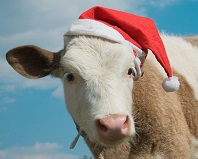Read the latest information on
Foot-and-mouth disease

With summer on the way, a large number of people will be on the move, taking advantage of warmer weather, longer days and public holidays. With more people travelling from region-to-region or from state-to-state, it’s time to consider the biosecurity risks posed by the movement of people, vehicles and animals around the country.
The reason we stop plant and animal materials crossing our international borders is obvious, but have you ever wondered why visitors to Australia are asked to declare whether they have been hiking, have been on a farm, or are bringing in items which may be soiled or muddy? As disease agents, weed seeds and some pests can hitch a ride undetected in the fabric of your clothes or the tread of your boots, people who have been in high-risk areas pose a far greater threat to our national biosecurity system.
The same is true of domestic travellers. Clothing, footwear, pets, tyres and undercarriages can all contribute to the movement of biosecurity hazards from high-risk to highly vulnerable areas. At a time when more people are on the move and travelling further afield, the likelihood of accidentally picking something up and taking it for a ride becomes much higher.
So what impact does this have on your on-farm biosecurity, and how can you ensure you’re protected? As always, the basic principles of biosecurity still apply: assess your farm, identify your risk factors, and work to reduce those risks.
For example, if your property borders or straddles a public gazetted road, double check your fencing and ensure gates are either locked or clearly signposted to ensure passers-by do not stray into the production areas of your farm. The same holds true for properties next to national parks, state forests and other areas of public land: ensure that hikers, cyclists or four-wheel drivers cannot accidentally find themselves in your paddock.
If practical, also limit contact between livestock and members of the public by ensuring animals are unable to reach fences adjoining public land, and continue to monitor the area surrounding public land and roads for signs of pests and weeds.
When accepting guests from out-of-town or interstate, whether they are family, friends or on a farm stay, ensure their vehicles remain in a designated parking area or are washed down prior to entering the property. This also applies to footwear and clothing. Your best bet is to limit any unnecessary contact between visitors and production areas, though this is not always practical. In this case, ensure you understand where your guests have been prior to your property and address their risk factor accordingly.
Of course, the most likely person to be travelling to and from your property is you. If you’re travelling this summer, make sure you aren’t tracking soil and mud on your vehicles and ensure you only pack clean clothing. Visit www.outbreak.gov.au to make sure you’re aware of any ongoing biosecurity responses in or around the locations you’ll be visiting. If you’ve been away, make sure you thoroughly clean or disinfect clothing, shoes and tyres before returning to work on your farm, especially if you’ve been visiting high-risk areas.
A few simple steps to secure your farm now will help ensure your future is secure well into the New Year. For more information on tightening up your on-farm biosecurity, visit the Farm Biosecurity website.